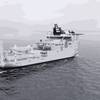New Crew Planning Software in Development
Hamburg-based ship-owning and ship management company E.R. Schiffahrt developed a Crew Compliance Optimizer, CCO, together with its partners Bernhard Schulte Shipmanagement and the scientists of the Fraunhofer Center for Maritime Logistics and Services (CML). "The maritime industry is in urgent need of an instrument capable of accurately planning the size and composition of the crew for a particular ship size and route and the work processes required during port stays," said Ole John, Senior Research Associate with Fraunhofer CML.
Route-specific planning on shore: The Office Module
The number of sailors needed on board essentially depends on how many are required to run the ship safely at all times and perform maintenance work in addition to that. To arrive at that number, the new system accounts for all route-specific details, such as the number of days at sea, the distances to be travelled between ports and the open sea, the laydays, the work processes planned in port, bunkering and restocking operations and many others. Working together closely with E. R. Schiffahrt's seafaring personnel, the scientists captured all onboard work packages, then merged them with detailed statistical data from the past 10-year period. Based on this empirical data the Office Module will calculate the number of seafarers needed for each route and the specific work to be done.
Continuous work schedule updates: The On-board Module
The On-board Module allows the ship's command to respond to changes occurring during a trip and adjust the work schedules accordingly. For example, if more time is spent in port than originally planned, the master can make the appropriate adjustments, such as reassigning watches so the required working and resting periods will be observed.
Automated documentation on board and on shore: The Reporting Module
The Reporting Module reduces the administrative effort traditionally associated with tracking and documenting working and resting hours. Time-consuming manual entries are no longer required. Instead the master simply presses a button to retrieve the documentation required for an audit. This will be especially convenient for shipping companies over the next several months since Port State Control has announced more frequent checks to verify adherence to the rules for working and resting hours. What is more, the relevant data is exchanged between the ship and the onshore office automatically.
Benefits for sailors, masters, ship managers and owners alike
Marc Gunther Schmidt, Executive in charge of crew management at E.R. Schiffahrt, summarized the benefits of Crew Compliance Optimizer for all stakeholders: "Sailors will profit from being able to stick to their assigned working and resting hours more easily. The ship's command benefits from a dramatically reduced timekeeping effort since working hours can be planned quickly and accurately using the system, which also provides plenty of flexibility for implementing changes during a trip whenever necessary. The master and ship manager can easily, at the push of a button, produce the required proof of adequate crewing during port state controls. As for shipowners, the crew costs, one of the most significant operating cost items, can be documented in a transparent manner, and the composition of the crew can be traced back with ease.
Both E.R. Schiffahrt and Bernhard Schulte Shipmanagement will subject the system prototype to extensive onboard testing under realistic conditions this autumn. The lessons learned will be used to further optimize the software.
The prototype will be presented at the SMM fair in Hamburg from September 9-12, 2014 at the Fraunhofer Stand in Hall B6, Stand 411.












